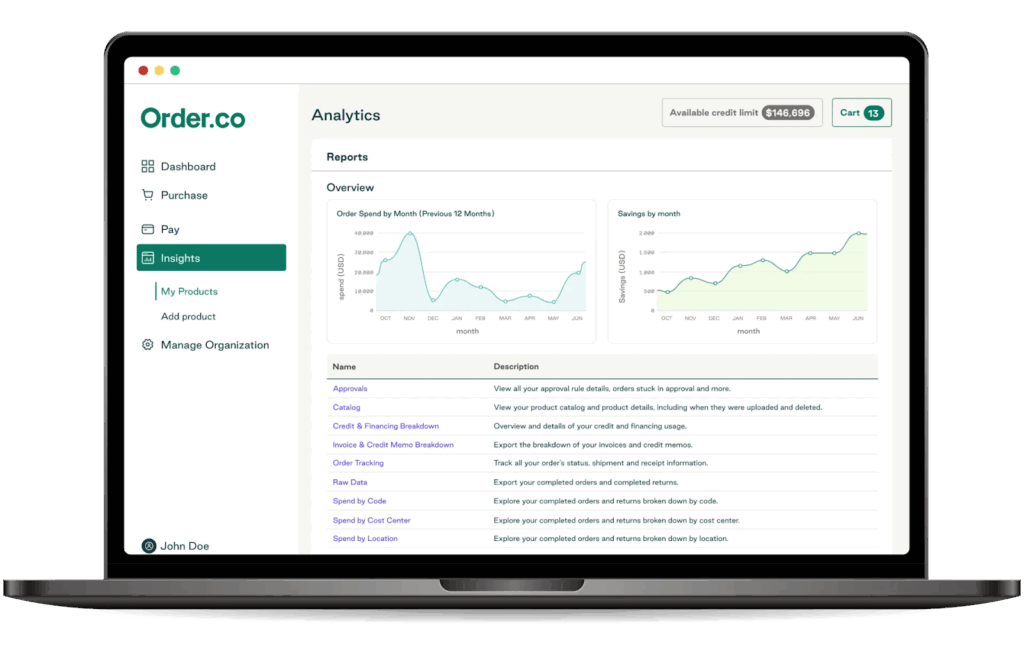20 Procurement Savings Tips for Smarter Spend Management

20 Procurement Savings Tips for Smarter Spend Management
As budgets tighten and companies look for ways to reduce spending, many seek out procurement savings to improve profitability. Because procurement expenses can significantly impact the cost-effectiveness of indirect spend, they are one of the most significant cost centers on the books. Implementing many small, systematic changes produces a combined effect that leads to better procurement outcomes over time.
This guide reveals the top 20 ways to simplify your P2P cycle and save money on procurement. It covers different types of procurement savings, ways to improve cost-efficiency, and ideas for reinvesting what you save—complete with real-life examples from companies that have applied these lessons.
Download the free ebook: The Procurement Strategy Playbook
What are procurement savings?
Procurement savings refer to the measurable cost reductions achieved through strategic sourcing, process improvements, vendor negotiations, and compliance enforcement. These realized savings can manifest in both direct and indirect ways, such as paying less for goods and services, avoiding future expenses through better planning, or optimizing workflows to reduce labor and time costs.
Cost savings are often a key performance indicator, so understanding how to maximize them is critical for reaching business goals.

What are the different types of procurement savings?
Depending on a company’s goals, purchasing volume, and industry, procurement savings can take multiple forms. The most common types of savings include:
- Hard savings: Tangible, direct decreases in unit prices or fees that immediately impact the bottom line
- Soft savings: Reductions in time, labor, or manual effort that indirectly lower costs
- Spend under management savings: Savings achieved by controlling spend through approved procurement processes and contracted vendors
- Working capital optimization: Improved cash flow through strategic payment terms and bulk purchasing discounts
- Total Cost of Ownership (TCO) savings: Savings across the product's entire lifecycle, including use, maintenance, and disposal
How do you calculate procurement savings?
You calculate procurement savings by subtracting your negotiated price from the baseline cost and multiplying that number by purchase volume. For simple ROI calculations, use this formula:
ROI = ((Total Savings – Total Procurement Costs) / Total Procurement Costs) × 100
It's important to track hard savings and soft savings separately. Hard savings directly affect your bottom line, while soft savings prevent future cost increases or operational inefficiencies.
Procurement cost savings ideas
Here are the 20 best strategies procurement leaders and managers use to positively impact spending:
- Create policy education for stakeholders: Well-documented spend policies establish expectations for buyers and decision-makers. Develop training and communications to ensure everyone spends efficiently and takes a proactive approach to procurement.
- Practice strategic sourcing: Transactional procurement often costs more than strategic sourcing, reflected in cost per unit, vendor responsiveness, turnaround time, and other soft metrics. Implement strategic sourcing practices to reduce costs and improve efficiency.
- Consolidate vendor lists: Vendor overlap decreases leverage by spreading addressable spend too thin. Consolidate vendors to improve supplier relationships and reduce the labor costs associated with vendor management.
- Curb maverick spending: Spending outside documented procurement processes drives up costs and creates information silos. Enforce procurement policies and find methods to reduce spot buys and corporate card expenditures.
- Establish spend approval rules: Once your procurement policy is in place, approval workflows ensure every purchase receives proper review. Define approval thresholds based on order size, category, location, role, or department, and include legal and security reviews for larger contracts.
- Decrease third-party risk: Companies spend millions of dollars mitigating the impact of information breaches and procurement fraud. Establish risk mitigation practices within procurement to protect against these costly incidents.
- Leverage your logo: Many vendors consider discounts or flexible terms in return for testimonials or case studies from top-tier business partners. Use your company’s brand reputation to negotiate better pricing and contract terms.
- Audit procurement costs: Unnecessary costs can fly under the radar without regular reporting and spend analysis. Commit to a regular reporting cadence to find savings opportunities and make contract adjustments.
- Use category management: As part of cost management, understand which spend categories represent your largest capital investment. Establish category management practices that address these big-ticket areas to find savings opportunities.
- Leverage volume discounts: Consolidating vendors allows you to leverage volume discounts for your most frequently purchased items. Use bulk discounts as a cost-saving measure for products and consumables and seek better pricing through a Group Purchasing Organization (GPO) or an all-in-one procurement platform like Order.co.
- Audit expense reports: Periodically auditing expense reports helps identify spending outside prescribed limits. Review expense reports regularly to uncover recurring purchases on employee credit cards that spend analysis efforts can’t capture.
- Manage inventory levels: Over-ordering and poor inventory management present liability issues and inefficiency in cash flow. Conduct inventory audits to prevent overages, shortfalls, and extra fees associated with rush deliveries.
- Simplify logistics: Trucking and logistics costs add up quickly when delivery services are too decentralized. Wherever possible, simplify logistics across locations to save on expensive trucking and warehousing fees.
- Conduct price benchmarking: Understanding how current vendor pricing compares to industry or internal standards allows procurement to negotiate more effectively. Benchmark prices to ensure your contract performance metrics remain strong over time.
- Consider multi-year agreements: Executing a multiyear contract with a trusted vendor can lead to lower prices for the contract's duration. Lock in interest rates and improved terms that increase cost savings and the deal's overall value.
- Reduce manual accounting work: Manually managing the procurement and accounting process is expensive and inefficient, and errors in accounts payable can result in extra fees, double payments, and the loss of early payment discounts. Reduce manual data entry and processing to drop your per-invoice accounting cost and save valuable overhead.
- Negotiate discounts: Building strong vendor relationships allows you to negotiate for better contract terms beyond the bottom line, such as improved payment terms or early pay discounts. Work with vendors to secure better deals and mutually beneficial agreements.
- Establish procurement KPIs: To improve cost savings, you need a way to quantify results. Establish desired procurement goals and savings tracking metrics, like contract performance, supply chain efficiency, and the total cost of ownership, to monitor savings.
- Set role-based spending limits: Outlining spend policies by department, role, organizational level, and team or location fine-tunes budgeting across the organization. Build dynamic controls to ensure everyone knows appropriate spending limits and where to go for exceptions.
- Use spend management software: Spend analysis software brings every type of expense into focus, allowing finance and accounting teams to plan and execute budgets and forecast efficiently. Use a spend management platform to access granular data regarding company spending and reveal opportunities to realize cost savings.

Real-life examples of procurement savings successes
Gaining better visibility into spending and optimizing purchasing processes can help organizations achieve significant savings. Here are two case studies highlighting those efforts in action:
CorePower Yoga
CorePower Yoga (CPY) had no visibility across purchases until the invoice arrived. This lack of insight and centralization resulted in frequent headaches regarding procurement activities and excessive maverick spending.
After investing in Order.co's spend management software, the CPY team achieved:
- A reduction of $50,000 in average monthly maverick spend
- $55,000 in annual cash savings
- 100% line-level visibility across purchasing processes
With better visibility and more cash to spare, CPY is now able to practice better decision-making about when and where it spends its money. “Now that we have order visibility with Order.co,” says Facilities and Property Management Specialist Stefanie Teintze, “we can run reports and review analytics to better project future spend based on past and current ordering trends.”
XpresSpa
Luxury travel spa business XpresSpa struggled with fragmented ordering across its 50 locations. By centralizing purchasing and training users on the new ordering system, it improved process visibility and reduced purchasing costs.
With the help of Order.co, XpresSpa was able to:
- Reduce management approvals required per order by 53%
- Save $68,000 in its first year through strategic sourcing initiatives
- Improve on-catalog compliance from 70% to 100%
“Order.co has helped us find savings and solutions to match ever-increasing demand,” says Tesh Ramsarup, XpresSpa's Operations Manager. “While the savings in dollars is clear to see, the immense time-savings for our spa field teams and spa support center cannot be underrated; any opportunity to remove a distraction and focus on our business is a welcome addition.”
What are the top procurement savings challenges?
Cutting costs in procurement is an achievable goal. But to succeed, you need to be wary of certain pitfalls. Failing to plan, measure, or implement your savings initiatives effectively may lead to net-negative results.
The top procurement savings challenges include:
- Establishing accurate baselines
- Ensuring savings measurement accuracy
- Managing supplier relationships during cost reduction initiatives
- Avoiding data quality issues
You can avoid these issues with the right process and system. Clear communication keeps relevant stakeholders updated and informed throughout implementation, while spend management software like Order.co helps ensure both data integrity and measurement accuracy.
How to develop a cost savings strategy
Establishing effective cost-reduction techniques requires strategic alignment across departments, data-driven decision-making, and consistent execution from all employees involved with purchasing. While it may seem daunting at first, the long-term benefits of a procurement savings strategy far outweigh any initial growing pains.
Here’s a step-by-step guide to help you get started:
- Assess current spend and processes: Start with a comprehensive spend analysis across products, vendors, and locations. Look for high-cost product categories, unmanaged tail spend, and duplicate or maverick spending.
- Set savings goals tied to business objectives: Whether you’re targeting a specific percentage reduction or a dollar amount, align your strategy with the company’s greater financial or operational goals.
- Prioritize high-impact initiatives: Focus on identifying savings opportunities with the greatest potential ROI, such as vendor consolidation, automated invoice processing, or sourcing cost-effective product alternatives.
- Build internal alignment and accountability: Ensure procurement, finance, and operations teams understand and support your strategy. Define responsibilities to track progress and keep everyone focused on their designated tasks.
- Monitor, optimize, and repeat: Establish regular check-ins to audit spend, review KPIs, and refine your spend management strategy based on real-time data.
Following these steps can help your business eliminate wasteful spending, improve vendor relationships, and maintain compliance while increasing time and cash flow for other priorities.
Ideas for reinvesting money saved on procurement
Now that you’ve freed up extra working capital and improved your financial position, where should you invest your procurement savings?
Here are a few reinvestment ideas to consider:
- Technology infrastructure: Deploy AI-powered procurement analytics, automated purchase-to-pay systems, and supplier risk management platforms for compound returns.
- Talent acquisition: Upskill procurement teams in strategic sourcing, data analysis, and supplier relationship management to drive additional savings.
- Supplier development programs: Invest in supplier diversity programs, sustainability certifications, and innovation partnerships to strengthen your supply base.
- Process improvement initiatives: Implement lean procurement methodologies, workflow automation, and change management capabilities to sustain savings over time.

What is cost savings versus cost avoidance?
When it comes to keeping money in the bank, companies can practice both cost savings and cost avoidance. Though cost savings is more frequently touted by procurement department leaders, cost avoidance is just as important.
Cost savings means reducing costs associated with a project, department, or location. You achieve cost savings by eliminating unnecessary waste, simplifying processes, and switching to less expensive products or services. Companies use cost savings to reduce expenses, increase efficiency, and maintain their competitive advantage.
Cost avoidance is about stopping spending before it occurs. Cost avoidance strategies include negotiating better deals with suppliers to avoid scheduled price increases or lock in interest rates, performing routine maintenance to prevent unnecessary replacement costs, and finding new ways to simplify operations to reduce labor expenses.
How Order.co helps procurement professionals increase procurement savings
Achieving procurement savings requires visibility, control, and efficiency across every purchase. Order.co’s spend management software helps with these efforts by centralizing spend, automating workflows, and providing actionable insights—while also supporting compliance with procurement policies.
Here are some of Order.co’s top features:
- Curated vendor lists: Order from a preferred list of vendors to ensure lower third-party risk and consistent vendor performance.
- AI Command Center: Deploy agents to automate tasks, assess spend history, and surface cost-savings initiatives.
- Spend analytics: Examine spend to enable data-informed decisions regarding future budgets and expenses.
- Automation approval workflows: Ensure every purchase meets organizational standards and receives proper review.
Book a demo today to discover how Order.co can help you maximize procurement savings through real-time spend controls and strategic sourcing features.
FAQs
Get started
Schedule a demo to see how Order.co can simplify buying for your business.
"*" indicates required fields



